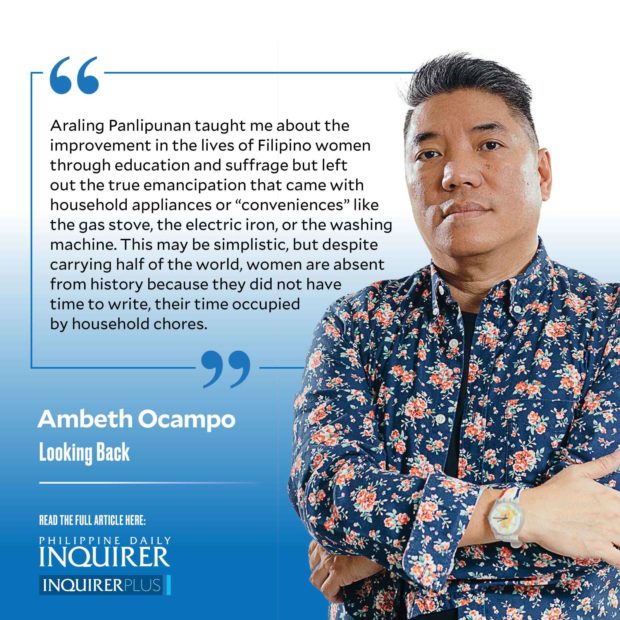‘Cooking ng ina ko’
Browsing in the supermarket inspired many reflections. The record-high prices for fruits and vegetables, notably onions, were an indicator of runaway inflation and the law of supply and demand that some bright congressmen of another generation sought to repeal. Then there were insta-meals, all-time Filipino staples like adobo, afritada, mechado, or paksiw in packs that could be warmed whole in boiling water or taken out of the packaging and heated on a stove or microwave oven. The cash-strapped need not have meat from these dishes, just the sauce on hot steaming rice now available in sachets. These reminded me of Nick Joaquin’s landmark essay that asked why Filipinos bought “tingi” or just one or two sticks of cigarettes rather than the whole pack. Does tingi suggest the Filipinos’ limited budget or a deeper “heritage of smallness”?
Microwave popcorn, and now also microwave chicharon, makes for instant pica-pica without the hassle of frying and having to wash up afterward. One need not cook sinigang from scratch anymore: sourcing tamarind, boiling it, extracting its essence through a sieve has become history with the introduction of instant sinigang mix and its improvement, the sinigang cube. One need not boil beef, pork, or chicken bones for broth anymore, those also come in bouillon cubes. What was the world like before Nissin invented instant ramen? Before instant mami and my favorite flavor, La Paz Batchoy, complete with a sachet of powdered chicharon?
Article continues after this advertisementAraling Panlipunan taught me about the improvement in the lives of Filipino women through education and suffrage but left out the true emancipation that came with household appliances or “conveniences” like the gas stove, the electric iron, or the washing machine. Fernando Amorsolo captured it so well in so many of his sunlit canvasses: beautiful dalagas bent by a clay stove, blowing delicately into a tube to coax embers to burn firewood. Dalagas cheerfully washing clothes in a stream, the outline of their voluptuous bodies impressed on them by their wet clothes. This may be simplistic, but despite carrying half of the world, women are absent from history because they did not have time to write, their time occupied by household chores. All the modern conveniences we take for granted like washer-dryers or wrinkle-free, ready-to-wear, non-iron clothes have given us more time to ourselves.
One of the many projects I have on the back burner is the publication of a selection of my mother’s recipes under the wonderful title “Cooking ng ina ko.” My mother’s well-deserved reputation as a good cook did not come by chance; she did not believe in cooking “oido” or instinctively. She was a stickler for exact weights, measures, and procedures. She always told us that with a kitchen-tested recipe, there will be no hits nor misses, what you cook will look, smell, and taste the same all the time. When I went abroad for graduate studies, she handed me a folder with typewritten “survival recipes” to remind me of home. Nothing fancy, just Filipino food using ingredients abroad. A recipe for dinuguan used blood sausage or morcilla, another for sinigang substituted trout for bangus, souring not with tamarind but a mix of tomatoes and lemon. She drew the fishhead with a note, “The fish is cooked when the eyes fall out.”
My mother’s recipes became relevant as I went through the T.H. Pardo de Tavera papers in the Ateneo Rizal Library, where one box contains notebooks and loose sheets of recipes by Juliana Gorricho (c.1842-1892), ill-fated mother-in-law of Juan Luna. I was fascinated by how she replicated the tastes of the Philippines in late 19th-century Paris, where they lived in exile. Recipes for sinigang, adobo, pancit, bagoong, etc., using ingredients available were a challenge to any cook. In a recipe for “albondigas” or meatballs, she used a mix of minced beef. The recipe good for 10 people was served on Sunday, Oct. 11, 1891, to Jose Rizal, Fernando Canon, Valentin Ventura, and a certain Vergel. On Jan. 1, 1886, she cooked sotanju (sotanghon) for Enrique, O’Farrell, Luna, and Resurreccion Hidalgo. Unlike the ordinary version with chicken broth, shrimp, and “tengang daga” (orejas de raton), this one was flavored from turkey carcass (leftover from Christmas?) and jamon de Bayona. Kitchen testing the Gorricho recipes like Julie in the film “Julie & Julia” will give me a taste of what our heroes ate.
Comments are welcome at aocampo@ateneo.edu

















